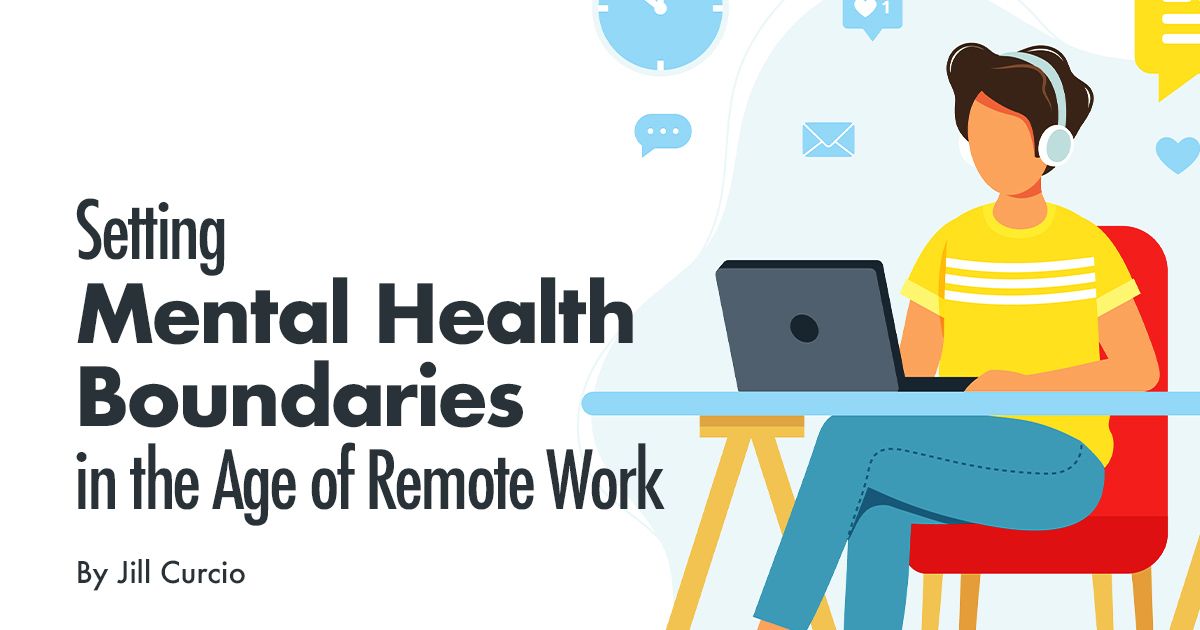If you are a serial binge-watcher like me, you may have heard about Apple TV+’s new series “Severance,” a futuristic series that focuses on the struggles of work/life balance. The show’s main characters sign up for a medical procedure to allow them to literally separate work from their home lives. This interesting premise is probably something that more than a few of us would consider, but there are easier (and less intrusive) ways to set boundaries.
For years, our work locations were physically separate from our houses—and we used the physical separation as a hard boundary. But when the world shifted to remote work, that physical boundary was stripped away, and we were forced to figure out how to set new boundaries. At first, we were in survival mode and setting boundaries seemed (and probably was) impossible. But now that many of us are coming into year two of at least partial remote work, we’re realizing that if we don’t set those boundaries, not only will our mental health suffer, but our productivity will as well.
So how do we set those boundaries and almost more importantly, how do we communicate and maintain them? Though I’ve only been working remotely full-time since October, I’ve been working at least partially remotely for the last four years and can share my own lessons learned in the hopes that you may take these to heart—and not feel like you need surgery to separate your work and home lives.
- Have a designated workspace—preferably one with a door. Even if this room is your bedroom and not a custom home-office, having a separate space with a door allows you to literally “shut the door” on work at the end of the workday. I know that when I get up from my desk and walk out of my “mini-office” (some extra space in my master bedroom) at the end of the workday, my workday is over.
- Protect your time. When you were in the office, you likely had set working hours. Even if you have them when you are home, it becomes harder to say no to an off-hour meeting. But if you don’t set the boundary (and communicate it), this can easily spiral out of control. Most people are willing to work within your set schedule, but in a remote environment, if they don’t know what it is, they can’t work around it. In my personal situation, my client has asked that I be reachable by phone between certain hours, so that’s what my working hours are. My team is made up of individuals in various time zones working variations of this schedule, but I’ve communicated that my day ends at the end of that window unless there’s an emergency.
- Silence your tools. To work more efficiently in a remote setting, most companies use a variety of tools to communicate with the workforce. At LMD, we rely heavily on Slack for internal communications, Microsoft Teams for client communications, and of course email. Once you’ve established your time parameters and taken steps to communicate (and thus, protect) your worktime, silencing your tools is a good follow-up for that. Slack has a feature that allows you to mute your notifications after a certain time. Using this setting lets your team members know that you’re off work and will follow up with them when you sign on again.
- Be adaptable. If we’ve learned nothing else from the past two years, it’s that we must be adaptable. I’ve laid out some rigid guidelines here, but I’ll be honest in saying I don’t always follow them. You know the saying “life happens”? Well, work happens too. Even though my day typically ends around 4 p.m. ET, that doesn’t mean that there aren’t evenings where I’m answering Slack messages at 7 p.m. or logging back on to finish something when my kids go to sleep. But it’s important that these are the exceptions and not the rule. If I log back on in the evening, it’s because something urgent or important is on my plate that I didn’t get to during the day. If I’m answering a Slack message at 7 p.m., it’s because one of my team members needs my help immediately.
As a leader of a large team, I try to model the behavior that I expect to see in those who report to me. I live by the philosophy that happy employees make productive employees. No one should be expected to be available around the clock—unless they signed up for that gig specifically. Everyone needs a healthy work/life balance to be successful and put their best foot forward professionally. Instead of trying to run an adult daycare, give employees the capacity to be professionals. You’ll be amazed at the results.
Jill is Program Manager for LMD's work with the Department of Homeland Security (DHS) Cybersecurity & Infrastructure Security Agency (CISA). She uses her leadership expertise and experience in cybersecurity to develop and manage CISA campaigns. Her attention to detail and organizational skills serve her well in her position as she manages the day-to-day campaign operations as well as long-term strategy. Jill has a B.A in corporate communications and spanish from Lycoming College.
